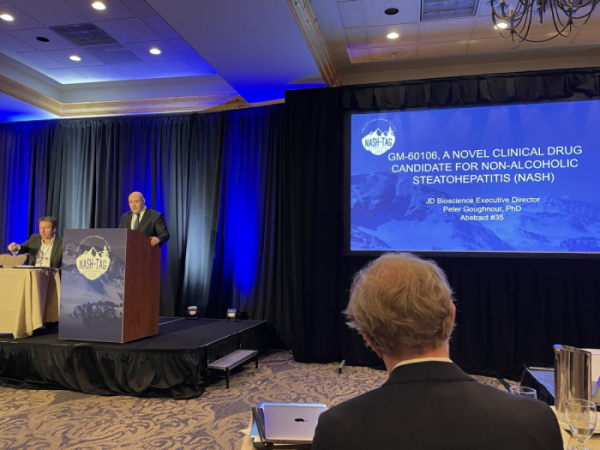기업
JD Bio, ‘HTR2A inhibitor’ MASH preclinical results “presented at the NASH-TAG conference”
by Changmin Shin
[NASH-TAG 2024] HTR2A inhibitor ‘GM-60106’ improves symptoms such as liver fibrosis and liver steatosis in mouse models. “Phase 1 clinical trial is expected to be completed in March.”

▲NASH-TAG presentation of Peter Goughnour, Executive Director of JD Bioscience
JD Bioscience announced on January 22 that it presented the preclinical results of the company’s MASH treatment candidate GM-60106 at ‘NASH-TAG 2024’, a conference specializing in metabolic dysfunction-associated steatohepatitis (MASH, formerly NASH) held in Park City, the United States from the 4th to the 6th.
GM-60106 is an oral HTR2A inhibitor, and JD Bio confirmed that the administration of GM-60106 in the MASH animal model improved symptoms related to MASH, such as liver fibrosis and steatosis.
JD Bio is currently undergoing phase 1a/1b clinical trial for GM-60106 in Australia and is expected to complete the clinical trial in March. JD Bio has completed the safety evaluation of phase 1a part and is undergoing phase 1b efficacy evaluation.
In particular, JD Bio’s research achievements were selected as Distinguished Abstracts by the NASH-TAG conference and were made through oral presentations. The company explained that it was able to be selected as a distinguished abstract due to its novel mechanism of action targeting HTR2A and positive research results.
5-Hydroxytryptamine Receptor 2A (HTR2A) is a serotonin (5-HT) receptor expressed in hepatocytes and hepatic stellate cells (HSCs); serotonin is known to cause lipid accumulation in the liver. GM-60106 blocks the serotonin signaling and causes therapeutic effect.
JD Bio designed with a structure in which GM-60106 cannot penetrate the blood-brain barrier (BBB), thereby minimizing the effect of drugs on the central nervous system (CNS). It is known that 95 percent of the body’s serotonin is synthesized in the intestine, not the brain.
According to the conference’s presentation, JD Bio confirmed the efficacy of GM-60106 in cell lines and mouse models that caused MASH. First, when GM-60106 was treated on HSC cell lines that cause fibrosis in the liver, α-SMA protein and collagen, which are markers of fibrosis, were found to decrease.
The company confirmed that when GM-60106 was administered in DIO (diet-induced obese) mouse model, its body fat and blood glucose were both reduced compared to the control group (vehicle). The liver tissue of the mouse model was then collected and histologically examined, and the dose-dependent improvement of hepatic steatosis, lobular inflammation, and ballooning, a morphological marker indicating damage to liver cells, was found.
JD Bio evaluated the safety of GM-60106 in a total of 88 healthy adults in the phase 1a clinical trial. As a result of the evaluation, a total of 26 drug-related adverse events were identified, all of which were grade 1 to 2, and no serious adverse events occurred. JD Bio is conducting phase 1b on 8 people with metabolic dysfunction-associated steatotic liver disease (MASLD) biomarkers such as hepatic steatosis, which has not developed into MASH, and is evaluating improvement of steatosis and liver fibrosis.
“At this conference, we were able to share our novel target with many doctors, pharmaceutical companies, and scientists,” said Jinhee Ahn, CEO of JD Bioscience. “Many attendees gave positive responses regarding JD Bioscience’s presentation and asked questions about the research.”
More than 200 liver specialists attended the NASH-TAG conference and presented their updated findings and therapeutics for MASLD, according to JD Bio. NASH-TAG will change its name to ‘MASH-TAG’ next year.



















